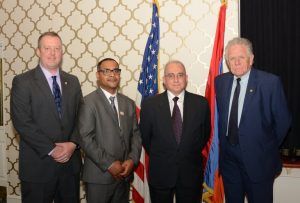A toast to Yerevan

The Armenian capital has compelling culture; but it will be the city’s homey hospitality that leaves the most lasting memory
The cluster of al fresco café bars surrounding me were animated with families enjoying the sunny weekend weather. The smell of strong fresh coffee wafted through the air, whilst from the table beside me I heard a cork being gently popped from a bottle and wine being poured. The atmosphere was quintessentially Mediterranean.
Crossroads
Yet I was in Yerevan, the capital of Armenia, a landlocked country at the heart of the south Caucasus. The region has a complex past; it’s where empires and cultures have collided for centuries. It may seem a cliché to suggest that the Caucasus is where east meets west, but that’s a fact. A strategic part of the world where Europe and Asia merge; where the traditionally Christian world meets Islam.
Armenia and its neighbours are attracting an ever-growing number of inquisitive visitors looking to discover the fascinating and intricate history of the region that was once part of the former Soviet Union.
Yerevan is a surprising destination. I wasn’t anticipating such a laid-back and super-friendly culture.
Cuisine
The local cuisine is excellent; farm fresh, simple, yet beautifully presented. To begin a meal in Yerevan means a series of cold sharing plates spread out across the table, accompanied by baskets of lavash flat-bread. Expect plenty of tasty vegetarian dishes, like slow-cooked, marinated aubergine and stuffed courgette. Pickled vegetables are popular too, together with creamy, soft or pickled cheeses. Armenians are proud of their cuisine and, in my experience, will often suggest their interpretation of regional dishes such as ‘dolma’ (grape vine leaves stuffed with vegetables or meat) or ‘zhingalov khats’ (lavash flat-bread stuffed with herbs, a speciality from Artsakh, Nagorno-Karabakh) are the best in the world.
The hot main dishes can be tasty grilled meats, like skewered lamb meat balls, or free-range chicken. Surprisingly the food is prepared without spices, and instead is marinated and cooked with abundant herbs like mint, coriander, basil and oregano.
National wines or beers are also usually served – and expect a decanter of vodka flavoured with seasonal fruits like Mulberry; or a bottle of the country’s famous Ararat brandy.
Be prepared to toast a lot in Armenia. At meals with friends, each person at the table might take part, each toast more poetic than the last: to friends, to the food, to country, and to family. It seems to perfectly encapsulate the warmth, and homey hospitality here.
The food scene is changing too. Since the war in Syria, thousands of Christian Armenian Syrians have migrated to Armenia. In a sad twist of history, many can trace back their ancestry to Armenians who had sought refuge in Syria a century before, escaping the genocide. These refugees have spiced up cuisine in Yerevan, opening new restaurants offering flavoursome Middle Eastern dishes, as well as spicy interpretations of classic Armenian recipes.
Culture
As a tourist it’s fascinating to visit some of the country’s ancient Christian monasteries if only to enjoy, from a secular perspective, their architecture and history.
One of the most spectacular is the 9th century Tatev Monastery. It’s almost four and half hours’ drive from Yerevan. Although Armenian driving standards can leave a lot to be desired, it’s well worth a hair-raising journey. The monastery is found on the edge of a stunning gorge and is reached by the ‘Wings of Tatev’ aerial tramway. These new glass cabins afford outstanding views above the gorge, before delivering you to the entrance of the monastery.
These are the kind of compelling cultural attractions that draw visitors to Armenia. My recommendation is to find a local guide as they will certainly bring the museums and galleries to life. My guide, Tigran, was a post graduate student. Smart, articulate and well-informed he was eager to engage and hear a foreigner’s perspective on European affairs, from Brexit to Catalonia.
Museums
Together we visited some of the city’s major cultural sights. First was the History Museum. It doesn’t sound enthralling, yet believe me once inside one is captivated by the remarkable artefacts and exhibits that tell the region’s story.
Yet the most memorable museum was the Matenadaran. It’s an exceptional research centre, a repository for thousands of priceless ancient books, manuscripts and documents in Armenian, a collection of UNESCO significance. Works show the unique Armenian alphabet as well as intricate, ancient illustrations.
Armenia, due to its geographical location has been the theatre of many conflicts. During visits to Yerevan’s museums and galleries you will often read or hear references to these events, including the Armenian genocide where many cultural artefacts were lost.
One morning I took a taxi up to the Armenian genocide memorial complex. This imposing memorial, built in the 1960s on the Tsitsernakaberd hill overlooking the city centre, is also home to a contemporary museum offering an insight into the Armenian genocide, during which 1.5 million Armenians were believed to have been killed by the Ottoman Turks. The architecture is rich in symbolism, as is the surrounding park.
Artsakh
For something quite extraordinary, travel agents in Yerevan offer trips to the nearby region of Nagorno-Karabakh, regarded by Armenians as the Republic of Artsakh. I somewhat naïvely took the opportunity to visit, without really considering the complexities or the implications of travel to the area. Tourism to the unrecognised republic is mainly targeted towards Armenians and the Armenian diaspora.
The journey to the self-proclaimed capital of Stepanakert is at least a six-hour drive from Yerevan, so really an entire day travelling through spectacular mountainous scenery. Arriving in the modest capital, with its government buildings, central square and café restaurants, it didn’t feel like a region that was living under the shadow of potential conflict.
Mountains and forests cover much of the region, making for spectacular hiking opportunities. The Hurnot Gorge is where one can find the unique Mamrot Qar ‘Umbrella’ waterfalls, huge moss-covered grottos over which fall clear mountain water. The landscape is dotted with ancient forts and religious complexes dating back centuries. The Gandzasar Monastery is without doubt one of the most striking; an example of ancient Christian architecture, built in a privileged location with panoramic views across the countryside.
The valleys are cultivated with orchards and vineyards. Following the wine harvest, I joined the Artsakh Wine Festival; a packed event, showcasing local wine producers, as well as combining a craft and art fair with local produce stalls and plenty of live entertainment. The air was thick with the smell of grilling meats and the smoke from tea urns heated by small fires beneath. It’s a day of tasting wines and eating local street food, to a boisterous soundtrack of local nationalistic songs and traditional ballads.
Artsakh, Nagorno-Karabakh feels like a land lost in time; a rural community that is quite the contrast to modern Yerevan in Armenia. It was fascinating to visit, but I can say that Yerevan and the surrounding area have so much to offer that there isn’t really the need to be so adventurous and travel there.
I suggest enjoying the laid-back café culture of the capital, its rich heritage of galleries and museums, the amazing food, and the welcoming people.
surinenglish.com




 Արևելահայերեն
Արևելահայերեն Արևմտահայերեն
Արևմտահայերեն Русский
Русский






